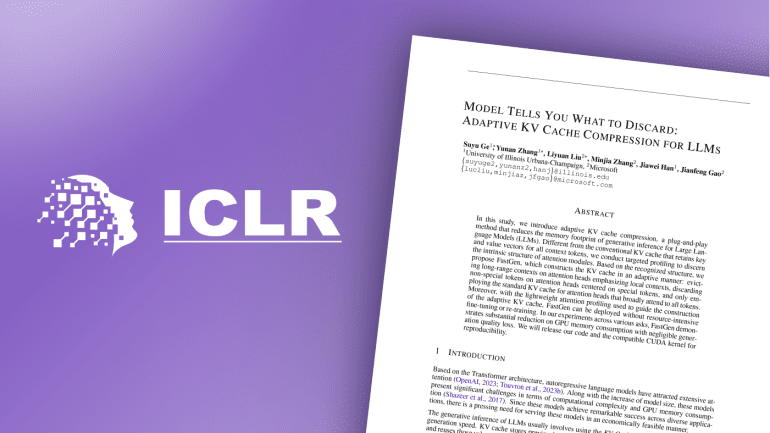- Microsoft introduces FastGen, a groundbreaking method for optimizing key-value (KV) cache in large language models (LLMs).
- FastGen reduces memory demands by up to 50% while maintaining LLM efficiency, as demonstrated in a paper presented at ICLR 2024.
- The method leverages adaptive KV cache compression, discarding unnecessary data to streamline memory utilization.
- FastGen’s efficacy is underscored by its recognition at ICLR 2024 with an Honorable Mention for the Outstanding Paper Award.
- Microsoft’s broader vision includes further enhancing resource efficiency in LLM applications through initiatives like Post-hoc Attention Steering for LLMs (PASTA).
Main AI News:
In the realm of artificial intelligence, large language models (LLMs) stand as towering pillars of computational prowess, reshaping how we interact with technology and perceive the boundaries of machine learning. However, as these models grow in sophistication and complexity, so too do the challenges associated with their operation, particularly in managing the monumental memory requirements demanded by their intricate internal mechanisms.
Microsoft, a perennial trailblazer in the AI landscape, has once again thrust innovation to the forefront with the unveiling of FastGen—a groundbreaking solution poised to redefine the landscape of LLM optimization. At the heart of this innovation lies the optimization of the key-value (KV) cache, a linchpin in the operational efficiency of LLMs.
The conventional KV cache serves as a repository for previously computed data, facilitating rapid responses by obviating the need for redundant recalculations. However, this convenience comes at a cost, with memory demands often ballooning to staggering proportions, reaching up to 320 GB for a single operation. Enter FastGen, a paradigm-shifting method meticulously crafted to alleviate this memory burden without compromising performance.
In a seminal paper titled “Model Tells You What to Discard: Adaptive KV Cache Compression for LLMs,” presented at the prestigious International Conference on Learning Representations (ICLR) 2024, Microsoft researchers elucidate the transformative potential of FastGen. By harnessing the power of adaptive KV cache compression, FastGen endeavors to slash memory utilization by half while preserving the unrivaled efficiency synonymous with LLMs.
Central to the development of FastGen is a profound understanding of the intricacies underlying the functionality of the KV cache. Through meticulous observations, Microsoft researchers unearthed pivotal insights, debunking the notion that every byte of data within the cache is indispensable for task completion. Leveraging this knowledge, FastGen empowers LLMs to discern and discard extraneous data, thereby streamlining memory utilization without compromising functionality.
Crucially, FastGen recognizes the heterogeneity inherent in various KV cache structures, necessitating a tailored approach to optimization. Through a process of meticulous profiling, FastGen discerns the idiosyncrasies of different modules within LLMs, enabling real-time adjustments to data storage strategies. The efficacy of FastGen is underscored by rigorous testing, demonstrating a remarkable 50% reduction in memory consumption without any discernible compromise in quality—an achievement heralded by an Honorable Mention for the Outstanding Paper Award at ICLR 2024.
Yet, FastGen represents merely a glimpse into Microsoft’s broader vision for the future of LLM optimization. Emboldened by the success of FastGen, Microsoft researchers are spearheading a multifaceted approach aimed at enhancing the resource efficiency of LLM applications. This endeavor encompasses not only memory optimization but also endeavors such as Post-hoc Attention Steering for LLMs (PASTA), which prioritizes controllability without the need for resource-intensive tuning or backpropagation.
As the AI landscape continues to evolve at a breakneck pace, Microsoft remains steadfast in its commitment to pioneering transformative solutions that democratize access to cutting-edge technologies. With FastGen and its ilk leading the charge, the horizon of possibility for LLM applications appears boundless, heralding a future where the power of language models is harnessed for the betterment of society at large.
Conclusion:
The introduction of Microsoft’s FastGen marks a significant milestone in the optimization of large language models (LLMs). By addressing the memory-intensive nature of KV cache operations, FastGen not only enhances the efficiency of LLMs but also signifies a broader trend towards resource-efficient AI solutions. This innovation has profound implications for the market, as it paves the way for broader adoption of sophisticated AI tools across various industries. With FastGen leading the charge, Microsoft is poised to redefine the landscape of LLM optimization, driving towards a future where cutting-edge technologies are more accessible and impactful than ever before.

